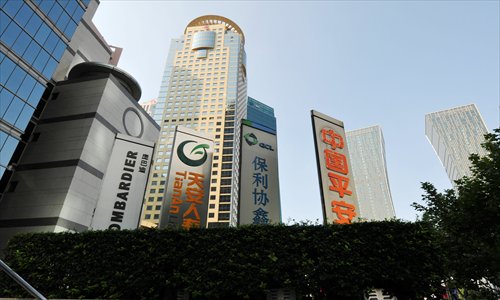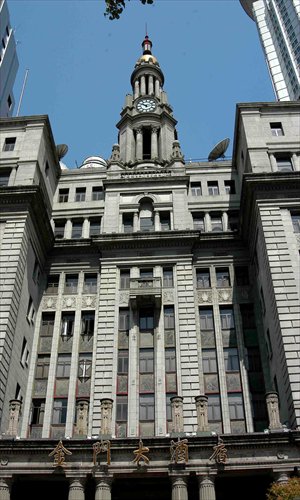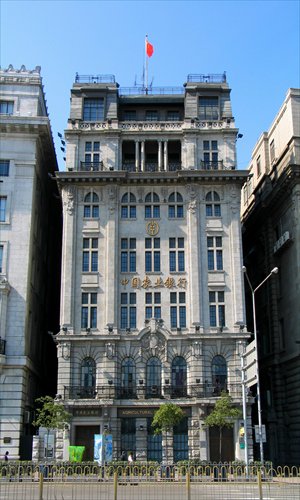Policies and profits
Editor's note
From a fishing village with a population of just 200,000 in 1843, Shanghai has developed into a huge modern city where more than 23 million people live. From the time Shanghai was forced to open up as a port in 1843, the city has witnessed remarkable change and progress. This year marks the 171st anniversary of Shanghai's opening-up and in this special series of reports, the Global Times will highlight some of the crucial moments, recall some choice memories of olden days and uncover some of the secrets of the city. Don't miss these exciting insights into the metropolis.

China's insurance industry began in Guangzhou in 1805 as a way of protecting shipping companies and shipowners in often unstable conditions. When Shanghai was opened as a port in the mid-19th century, foreign insurance companies expanded north and the insurance business grew quickly with Shanghai becoming the insurance base for China.
In the early days the foreign insurance companies authorized other companies to handle insurance policies and claims but in 1857 the first Shanghai insurance company, the Canton Insurance Society, was launched by the British trading house Jardine Matheson.
By 1911 more than 161 foreign insurance companies from 14 countries were thriving in Shanghai - 90 were British firms, 209 German and 13 American. Six companies established their headquarters here - the Yangtze Insurance Association, the North China Insurance Association, the China & Japan Marine Insurance, the New China & Japan Marine Insurance, the China Mutual Life Insurance and the Shanghai Life Insurance.
More than 40 percent of the early insurance companies handled shipping insurance and 32 percent offered fire insurance with 15.6 percent offering to cover both marine and fire accidents. Only a few companies offered life insurance in those days.
Dominating the market
The Yangtze Insurance Association, one of the most influential insurance companies, was established in 1862 by Russell & Co, the largest and most prominent American trading house in China. It operated in China from 1842 until it closed down in 1891. Russell & Co's shipping company had dominated the market for passengers and goods on the Yangtze River and to reduce losses from shipping accidents, the trading house started its insurance arm to reduce the investment risks.
At first its insurance business was conducted at No.9 on the Bund (now the home to the fashion store Shiatzy Chen). In 1891 when Russell & Co was closed down it became an independent British company with branches in Hong Kong, London, New York and Singapore and more than 30 agents in other Chinese ports.
In 1928, the Yangtze Insurance Association built a new headquarters at No.26 on the Bund, on land which had belonged to the Sassoon Family. The imposing neoclassical style seven-story building (now the Agricultural Bank of China's Bund branch) was home for the company until the Japanese invaded and sequestered its operations. After the war in the 1940s the building attracted other insurance companies to set up offices there and it became the city's "insurance home."
After the founding of the People's Republic of China (PRC) in 1949 the company moved to Hong Kong. The Yangtze Insurance Building was listed as heritage architecture by the Shanghai Municipal Government in 1999.
From 1912 to 1941, the number of foreign insurance companies in Shanghai kept rising. More than 227 companies from 19 countries opened offices with the British continuing to dominate the market, having 87 companies operating here alongside 43 US companies and 17 Japanese firms.

Legendary figures
Two different but legendary figures set the insurance business in Shanghai on its own distinctive path. The American businessman, Cornelius Van der Starr, founded the American International Group (AIG), a major corporation in the 21st century and became known as the insurance tycoon of Shanghai.
Starr was born in Chicago, Illinois and worked in newspapers, law firms and insurance companies when he was still studying at the University of California. His first successful business was selling ice creams when he was 19. His varied background gave him an edge and turned him into a quick-thinking man of ideas.
When he arrived in Shanghai in 1916, several insurance companies offered him employment but eventually he caught the eye of E. J. Raven, the boss of the American Oriental Banking Corporation who put the young man in charge of the bank's insurance business.
In December 1919, C. V. Starr opened his first business, American Asiatic Underwriters, and acted as an agent for the American Foreign Insurance Association's business in China. By 1925 Starr had developed his business into a company worth $1 million. He then launched the Asia Life Insurance, the American International Underwriters Corporation and other new insurance companies. By the late 1930s, American Asiatic Underwriters dominated the Chinese insurance market and had branches in 46 countries and regions.
Starr was very good at his business. When he created the American Asiatic Underwriters, he named it the Underwriters Savings Bank for the Far East Inc. People felt at home with this - the abbreviation USB reminded many of a US bank (this was to become the international giant AIG).
He bought the New York Life Insurance simply for its name. He promoted the company claiming its headquarters stood on a large street in New York although in fact it had been just one small office there. His bold approaches were legendary. When businessmen struggled to find an insurance company willing to cover the stock they had stored in a warehouse on Suzhou Creek because the building was run-down and there was a big fire risk Starr offered to insure the premises - but only if the businessmen all agreed to insure everything they owned with him.
The power of advertising
He also understood the power of advertising. He told his artists to draw an image of a man holding his wife and children in the palm of his hand - the accompanying words explained that a man's life, wife and children were in his hands and a happy family needed life insurance to be happy.
He advertised in cinemas and placed posters on the streets in Hangzhou and Ningbo. Business boomed even more after he established the newspaper, the Shanghai Evening Post and Mercury, in 1933, which frequently ran stories about people being grateful for their insurance.
By 1937, American Asiatic Underwriters controlled 30 percent of the insurance market in China. In 1939, Starr moved his headquarters from Shanghai to New York. Starr himself left Shanghai before the PRC was founded in 1949.
The first Chinese insurance company was opened in 1865 by Chinese merchants, who found it had become crucial to have their own insurance companies. At that time, foreign insurance companies and agencies had a monopoly on the business and Chinese businessmen were not only asked to pay high premiums but were often refused cover if their business conflicted with a foreign interest.
The insurance business also brought about the establishment of the city fire brigade which was set up in the concessions in 1867 after agreements between insurance companies, banks and the Chinese government. The insurance companies paid the running expenses of the brigade, and later the Chinese community organized its own fire brigade which was largely funded by donations from wealthy people.
By 1911, Shanghai had 33 Chinese independent insurance companies - 58 percent handled fire and maritime insurance and just 12 percent offered life insurance. However with the intense competition in the market none of these companies survived.
Then in 1912, another major figure arrived on the insurance scene in Shanghai. Lü Yuequan established the first Chinese life insurance company, the China United Assurance Society, which was to become one of the largest and most influential Chinese companies.
Born into a poor fishing family in Pudong New Area, Lü sported large ears and eyes - traditionally a sign of fortune. Although his father struggled to get the boy an education, Lü had to quit school when he was 12. An uncle got him a job as a errand boy for a British family, whose father was a manager with a British insurance company.
After the father failed to find a suitable applicant for a position in his firm he offered Lü a chance and the young man accepted it quickly. He began selling insurance to the Chinese and his hard work and patience began to pay off.
After eight years, Lü was promoted to manage the company's Nanjing branch and in Nanjing, conceived the idea of creating a Chinese insurance company. In 1911 the China United Assurance Society opened at No.30 on the Bund with Lü as the manager.
As well as running and expanding the business Lü ensured that proper training systems for insurance professionals were established. When the China United Assurance Society was established, Chinese insurance companies were famous for their chaotic management and ignorance of the insurance business. Lü hired two former colleagues from the British company he used to work for and sent them assistants who were willing to learn. The assistants became managers themselves and went on to train others. Lü also worked with universities and colleges to encourage them to offer appropriate courses for insurance professionals.

A splendid building
By 1919, 34,000 households in Shanghai had policies with the China United Assurance Society, which earned the company 1 million silver dollars. Lü invested in land and property, spending more than 500,000 silver dollars on a 6,667-square-meter section on today's Nanjing Road West in 1922 and he spent another 700,000 silver dollars constructing a splendid nine-story building, a head office for his company, which today is the Pacific Hotel.
Lü's business suffered from 1931 to 1939, when Japanese military incursions ravaged China. He refused to cooperate with the Japanese and his business never recovered. Lü had to sell his own property to pay his workers. In 1953 he died of illness in Hong Kong - but not before he had signed his business over to the city government. In 1954, the government completed the deal and discovered that the China United Assurance Society still held 8,500 active household policies.
After the liberation of China, Shanghai's insurance business developed anew but it was suspended during the Great Leap Forward (1958-61) and the Cultural Revolution (1966-76).